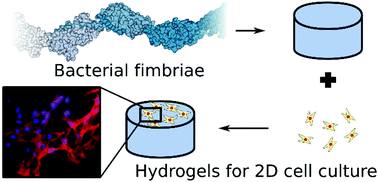Hydrogels of engineered bacterial fimbriae can finely tune 2D human cell culture†
Abstract
Demand continues to grow for biomimetic materials able to create well-defined environments for modulating the behaviour of living cells in culture. Here, we describe hydrogels based upon the polymeric bacterial fimbriae protein capsular antigen fragment 1 (Caf1) that presents tunable biological properties for enhanced tissue cell culture applications. We demonstrate how Caf1 hydrogels can regulate cellular functions such as spreading, proliferation and matrix deposition of human dermal fibroblast cells (hDFBs). Caf1 hydrogels exploring a range of mechanical properties were prepared using copolymers featuring controlled compositions of inert wild-type Caf1 subunits and a mutant subunit displaying the RGDS peptide motif. The hydrogels showed excellent cytocompatibility with hDFBs and the ability to modulate both cell morphology and matrix deposition. Interestingly, Caf1 hydrogels displaying faster stress relaxation were demonstrated to show the highest metabolic activities of growing cells in comparison with other Caf1 hydrogel formulations. The stiffest Caf1 hydrogel impacted cellular morphology, inducing alignment of the cells. This work is significant as it clearly indicates that Caf1-based hydrogels offer tuneable biochemical and mechanical substrates conditions suitable for cell culture applications.



 Please wait while we load your content...
Please wait while we load your content...